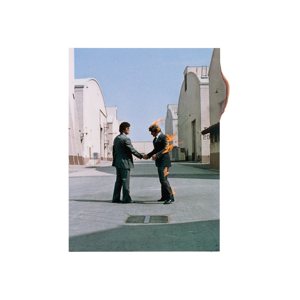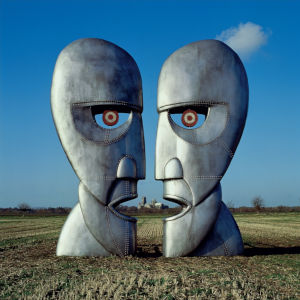
The Dark Side of the Moon is the eighth studio album by the English rock band Pink Floyd, released on 1 March 1973 by Harvest Records in the UK and Capitol Records in the US. Developed during live performances before recording began, it was conceived as a concept album that would focus on the pressures faced by the band during their arduous lifestyle, and also deal with the mental health problems of the former band member Syd Barrett, who had departed the group in 1968. New material was recorded in two sessions in 1972 and 1973 at EMI Studios in London.

The Wall is the eleventh studio album by the English rock band Pink Floyd, released on 30 November 1979 by Harvest/EMI and Columbia/CBS Records. It is a rock opera which explores Pink, a jaded rock star, as he constructs a psychological "wall" of social isolation. The Wall topped the US charts for 15 weeks and reached number three in the UK. It initially received mixed reviews from critics, many of whom found it overblown and pretentious, but later received accolades as one of the greatest albums of all time.

Animals is the tenth studio album by the English rock band Pink Floyd, released on 21 January 1977, by Harvest Records and Columbia Records. Pink Floyd produced it at their new studio, Britannia Row Studios, in London throughout 1976. The album continued the long-form compositions that made up such previous works as Meddle (1971) and Wish You Were Here (1975).

Wish You Were Here is the ninth studio album by the English rock band Pink Floyd, released on 12 September 1975 through Harvest Records in the UK and Columbia Records in the US, their first for the label. Based on material Pink Floyd composed while performing in Europe, Wish You Were Here was recorded over numerous sessions throughout 1975 at EMI Studios in London.

Meddle is the sixth studio album by the English rock band Pink Floyd, released by Harvest Records on 5 November 1971 in the United Kingdom. The album was produced between the band's touring commitments, from January to August 1971 at a series of locations around London, including EMI Studios and Morgan Studios.

The Division Bell is the fourteenth studio album by the English rock band Pink Floyd, released on 28 March 1994 by EMI Records in the United Kingdom and on 5 April by Columbia Records in the United States.

The Final Cut is the twelfth studio album by the English rock band Pink Floyd, released on 21 March 1983 through Harvest and Columbia Records. It comprises unused material from the band's previous studio album, The Wall (1979), alongside new material recorded throughout 1982.

Echoes: The Best of Pink Floyd is the fourth compilation album by the English rock band Pink Floyd, released on 5 November 2001 by EMI internationally and a day later by Capitol Records in the United States. It debuted at No. 2 on the Billboard 200 album chart on 24 November 2001, with sales of 214,650 copies. It remained on the chart for 26 weeks. The album was certified gold, platinum and double platinum on 6 December 2001 in the US by the RIAA. It was certified triple platinum in the US on 8 January 2002, and quadruple platinum on 10 September 2007.

Relics is a 1971 compilation album by English progressive rock band Pink Floyd. The album was released in the UK on 14 May 1971 and in the United States on the following day. Initially released by Starline, the compilation was reissued by Music for Pleasure in the United Kingdom, while Harvest and Capitol distributed the album in the United States. A remastered CD was released in 1996 with a different album cover, picturing a three-dimensional model based on the sketch drawn by drummer Nick Mason for the album's initial release.

Amused to Death is the third studio album by English musician Roger Waters, released 7 September 1992 on Columbia. Produced by Waters and Patrick Leonard, it was mixed in QSound to enhance its spatial feel. The album features Jeff Beck on lead guitar on several tracks. The album's title was inspired by Neil Postman's 1985 book Amusing Ourselves to Death.

A Collection of Great Dance Songs is a compilation album by the English rock band Pink Floyd. It was released on 23 November 1981 in the United Kingdom by Harvest Records and in the United States by Columbia Records.

"Money" is a song by English rock band Pink Floyd from their 1973 album The Dark Side of the Moon. Written by Roger Waters, it opened side two of the original album. Released as a single, it became the band's first hit in the United States, reaching number 10 in Cash Box magazine and number 13 on the Billboard Hot 100.

Shine On is a nine-CD box set by English rock band Pink Floyd, released in 1992 through EMI Records in the United Kingdom and Columbia Records in the United States, to coincide with Pink Floyd's 25th anniversary as a recording and touring band. All CDs were digitally remastered.

Is There Anybody Out There? The Wall Live 1980–81 is a live album released by Pink Floyd in 2000. It is a live rendition of The Wall, produced and engineered by James Guthrie, with tracks selected from the August 1980 and June 1981 performances at Earls Court in London. The album was first released in the United Kingdom on 27 March 2000, and a US/Canadian release by Columbia Records on 18 April.

Pink Floyd are an English rock band formed in London in 1965. Gaining an early following as one of the first British psychedelic groups, they were distinguished by their extended compositions, sonic experiments, philosophical lyrics, and elaborate live shows. They became a leading band of the progressive rock genre, cited by some as the greatest progressive rock band of all time.

"Hello (I Love You)" is a song performed by former Pink Floyd member Roger Waters. The song was created as a collaborative effort with Howard Shore for the 2007 film The Last Mimzy.

Oh, by the Way is a compilation boxed set by Pink Floyd released on 10 December 2007, by EMI Records in the United Kingdom and the following day in the United States through Capitol Records.
Andrew Brook Jackson is a British recording engineer, best known for his work with the British progressive rock band Pink Floyd. He was also the owner and operator of Tube Mastering, a private studio specializing in recorded music mastering.

Doug Sax was an American mastering engineer from Los Angeles, California. He mastered three The Doors' albums, including their 1967 debut; six Pink Floyd's albums, including The Wall; Ray Charles' multiple-Grammy winner Genius Loves Company in 2004, and Bob Dylan's 36th studio album Shadows in the Night in 2015.

The Later Years is a box set by the English rock band Pink Floyd released on 13 December 2019 by Pink Floyd Records. It follows the 2016 box set The Early Years 1965–1972, and compiles Pink Floyd's work under the leadership of David Gilmour after the departure of Roger Waters in 1985.

















